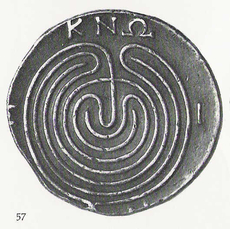Blå Jungfrun Island
Labyrinth *
Labyrinths, are one of the many mysteries of the ancient world, with the earliest examples apparently dating back around 4,000 years(t). In Egypt, around 1800 BC Pharaoh Amenemhet III was responsible for building what is reputed to have been the largest labyrinth at Hawara containing three thousand rooms according to Herodotus, who visited it in the 5th century BC. Herodotus’ description inspired Athanasius Kircher to draw a plan of the underground complex(u).
The Labyrinth along with the double-headed axe, the labyris, are usually associated with Minoan culture. However, the labyrinth is an ancient symbol found around the world in locations such as Italy(s), India(g), Egypt(h), England(q), Finland(r)and even in the New World as Evan Hadingham has shown an example [1309.261] at Pacatnamú in Peru. In Scandinavia, they are known as Troy Towns – Trojeborgar. Sweden has the greatest number with 200(e).
The largest example in Sweden was discovered at the Mesolithic site on Blå Jungfrun Island(j).
Tracy Boyd, in a lengthy paper(m) about Chartres Cathedral, mentions in footnote 27 that “Many of the labyrinths originally installed in cathedrals in France were later destroyed by the Church itself”!
Eberhard Zangger claimed that “most labyrinths are found around the Mediterranean” and “that at the end of the Bronze Age, the labyrinth was a recognised pattern around the eastern Mediterranean.” [484.136] He proceeds to link the labyrinth with Troy, which, in an earlier book [483] he had identified as Atlantis.
India’s second-largest example, measuring 56 feet by 56 feet, was partly uncovered in Gedimedu near Pollachi(i) in 2015. It is estimated to be 2,000 years old and has a design similar to those found on clay tablets found at Pylos, Greece, from 1200 BC.
Labyrinths were also incorporated into very many churches and cathedrals throughout Europe. Lucile Taylor Hansen gives some examples of mazes in the United States[572.276].
It has been suggested by a number of writers that the labyrinth had some connection with Atlantis(a)(b). Such suggestions are interesting but highly speculative. Lewis Spence does so in The History of Atlantis. J. D. Brady touches on this in his book, Atlantis[0738] where he announced that Atlantean gold treasure was to be found within a labyrinth on the Greek island of Lemnos.
What I find interesting is that so many widespread examples of the labyrinth retain the irregular elements of the symbol even when depicted in a rectangular rather than a rounded style. An extensive website covering all aspects of labyrinths and mazes is worth a visit(c). There is also The Labyrinth Society(f) to further whet your appetite.
In 2014 an article(o) by April Holloway described a collection of labyrinths that I consider the most mysterious of all. They are situated on Russia’s Solovetsky Islands (or Solovki), which “are an archipelago located in the Onega Bay of the White Sea, Russia. It is here where there can be found thirty-five Neolithic labyrinths, known as ‘vavilons’ (‘Babylons’) in the local dialect, which date back to around 3,000 BC. The most remarkable are the stone labyrinths of Bolshoi Zayatsky Island, a group of fourteen labyrinths in a 0.4km 2 area.” The Atlas Obscura website offers a number of images(p).
In 2017, an extensive article by John Reppion offers further information on the history and geographical spread of labyrinths(k). Similarly, Gary Vey offers an article with additional information and more images(l).
Some researchers have attempted to link the outline of the labyrinth with the concentric design of the harbour of Plato’s capital city. The harbour was described as a series of perfectly concentric circular features ‘as if created on a lathe’ (Critias 113d), whereas the labyrinth is more spiral with a slightly offset entrance. My conclusion regarding the labyrinth is; fascinating– yes, Atlantis – probably not.
The persistent use of this ancient symbol was highlighted by an aerial image, sent to me by Hank Harrison, of a Catholic school in California.
(a) MMM Group Home Page (archive.org)
(b) www.duepassinelmistero.com/Il%20mito%20di%20Atlantide.htm
(c) Labyrinthos Homepage (archive.org)
(e) https://www.mymaze.de/trojaburg_en.htm
(f) The Labyrinth Society: The Labyrinth Society: Sacred Geometry and Labyrinths (archive.org) *
(h) https://www.ancient-origins.net/ancient-places-africa/lost-labyrinth-ancient-egypt-part-1-002033
(k) https://dailygrail.com/Guest-Articles/2017/7/The-Labyrinths-Troy
(l) Labyrinth: walk on the wild side / Viewzone
(m) our lady of chartres (archive.org)
(o) https://www.ancient-origins.net/ancient-places-asia/ancient-stone-labyrinths-bolshoi-zayatsky-001573
(p) https://www.atlasobscura.com/places/bolshoi-zayatsky-island
(q) https://andrewgough.co.uk/articles_land/
(r) Labyrinths and Ritual in Scandinavia | BLADE HONER (wordpress.com)


